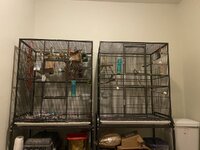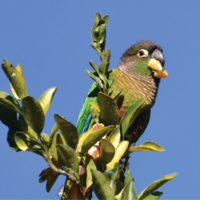Of all my years of experience with keeping pets (mainly dogs and aquatics), everything that I have ever read on food ingredients has written off corn, wheat, and soy as mediocre&terrible ingredients for animal feed.
Now going through ingredients lists of bird pellets (primarily for parakeets), those three ingredients seem to top the list for every prepared food that I have seen being recommended in these forums. Does the commonly accepted idea that corn, wheat, and soy are bad/cheap filler ingredients still apply when it comes to birds? Or are they actually able to process and utilize whatever nutrients may be available in those particular ingredients and thus they should be of no concern when it comes to the composition of the pellets?
Following that question, which pellets have you found to be the most readily accepted by birds that have been primarily raised on seeds?
I see you have 51 replies, so it’s likely you’ve heard close to 51 opinions! I will give you mine. It’s long-winded but hopefully informative.
First, consider that we keep birds from all over the world with vastly different diets in the wild, yet the same staple diet is recommended for all of them, with a few exceptions. It doesn’t add up.
I think that pellets are probably better for some species than others, either because pellets are closer to what they’d eat in the wild, or because some species are more adaptable to unnatural food sources.
Most avian nutrition research has been in agriculture, mostly on chickens. So maybe pellets make great chicken food.
I have an eclectus, and they respond so poorly to pellets that it’s a an absolute no-no, but I noticed significantly improved plumage and activity levels in my gcc when I shifted his diet to fruit/veggies and seed years ago. My cockatiel gets seeds and greens. I adopted my eclectus recently and am still figuring him out but he gets majority fruits and veggies.
Read everything you can about what your species eats in the wild. If possible, get into the scientific literature and read field studies, where biologists have actually followed wild flocks, observed what they eat, and calculated the percentages of what they consume. If possible find studies that have observed diets in different seasons and regions. The scientific language is not a fascinating read. Flip through until you find tables with food species and percentages. Foods are usually listed by scientific names, but pop that into Google and there ya go. Some of science language text could be useful, but don’t worry if it isn’t.
Many parrots are jungle birds and feed in the canopy, not on the ground. Figs are frequently a major component of these birds’ diets because (to my knowledge) they grow in most if not all jungles and fruit year-round.
You will never be able to get them exactly what they eat in the wild, but take a look at the nutritional properties of those foods and try to match them as best you can.
I will describe the adaptations I’ve made for my green cheek and cockatiel as examples.
Green cheeks eat 70% figs in the wild. Figs are much higher in fiber and lower in sugar than most fruits we eat. Wild figs are even lower in sugar than domestic figs. This means that for bender I give him fresh figs whenever I can find them, which is only for a few weeks of the year. So I try to go for lower-sugar fruits and veggies with high fiber. Raspberries and blackberries have a high sugar content but like figs contain a lot of seeds so I like to feed those. Blueberries aren’t quite as sweet as other fruits and are nutritious so I like to feed those when I can. Bananas are ideal due to the fiber content but bender refuses to eat them or even other foods that they’ve touched! Such drama! I’ve been trying to get him eating kale but it’s an uphill battle. He’s very calculating. If you give him a small amount of grape or pomegranate (favorites) he will eat only that, ignore other fresh foods, and eat every single one of the foraging items described below. He’s a gremlin and it’s a constant back and forth!
Conures eat some seeds in the wild, and benders favorite treat is dry macaroni. And it must be elbow macaroni - other kinds of pasta are unacceptable to him!! To keep him from becoming a seed junkie and keep him busy I give him “foraging bags” which are paper lunch bags filled with newspaper I’ve put through a shredder, 1 tbsp seeds, 1 tsp macaroni, 5-6 zupreem pellets for micronutrients. He gets a new one every day. This means that if he wants seeds he has to work quite hard for them - I put in a lot of paper with food at the top. This strategy probably won’t work for a parakeet as it requires a lot of dexterity and energy.
To make sure bender gets protein, calcium and vitamin A reliably, he gets 1 tbsp egg food weekly, which he gobbles down.
Lulu is a grass bird. I’m guessing parakeets might have similar diets but I haven’t read about it. Cockatiels eat mostly grass seeds, quite a bit of plant matter, and the occasional insect.
She gets finch/canary seeds, as those mixes contain more grass seeds. Cockatiel seed mixes are full of millet, sunflower seeds and safflower seeds which are starch and fat. She gets 1 tbsp seeds daily
Getting her to eat greens is a challenge. I chop the very tips off broccoli or cauliflower florets and mix them in with her seeds - she then eats them like seeds! I usually top that with a few chunks of cabbage from a chopped salad mix I eat.
To get the protein from insects in, I tried dried meal worms. Yuk for me, and luckily she wouldn’t eat them! I now give 1/2 tbsp egg food every other day. That also has calcium which is good for the female tiels in particular
She gets a separate bowl of wet kale. Cockatiels are lettuce bathers. She’ll bathe in that and eat some of it while she’s at it.
Foraging is always good but lulu is not as smart or dexterous as bender so we are working on that.
Eclectus nutrition is one of avicultures great mysteries. After I figure it out over the next few years or more, I’ll write a book.
So, that’s a long-winded way of saying that diets should be species-specific and re-create whats fed in the wild. Lots of fresh food and variety. Look up fruits and veggies to avoid (avocado and uncooked potatoes come to mind) and ask in the forum.
A note on seeds and pellets. Seeds are now considered almost toxic by many bird owners and even vets, and some will tell you you’re killing your bird by giving them at all! Most of this info is based off of all-seed diets, which are bad for them indeed, especially majority fruit-eaters. But some species, like cockatiels, eat majority seeds. However, the nutritional content of seeds varies greatly between types of seeds. That’s why you should aim as close as possible for seed types they eat in the wild. That’s why my cockatiel gets finch seed and I try to give my green cheek as much seedy fruit as possible.
Pellet companies actually conduct continuing education courses for avian vets. Continuing education of some form is required to keep their licenses. This means that even many vets are over-hyped on pellets and receive over-exaggerated information on the dangers of seeds. Nutrition articles written for bird owners are frequently written by pellet companies.
Finally, when we consider a human’s diet, exercise is almost always part of the conversation. It should be for birds too. My GCC and cockatiel have huge cages for their size (see below). My ekkie will get an upgrade sometime in the next year. My GCC likes to play so his is chock-full of toys and of course his foraging bags. My cockatiel is afraid of toys (we’re working on it) so hers is almost empty, but that gives her plenty of room to fly, which she does a lot of.
Wing clipping is controversial and not this thread’s topic. But I will say that everything about a birds physiology is based on their ability to fly, and there’s no better form of exercise. Vets are always surprised by the muscling on my birds. GCC and cockatiel have been fully flighted for years. Safety is a major concern. Homes with children are especially problematic. Head over to the flight deck for more info, feel free to PM me.




 , like I want to know and read and am genuinely curious, so please don't ", read it" as obnoxious
, like I want to know and read and am genuinely curious, so please don't ", read it" as obnoxious 
